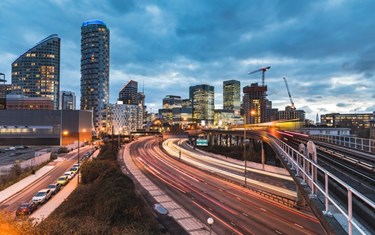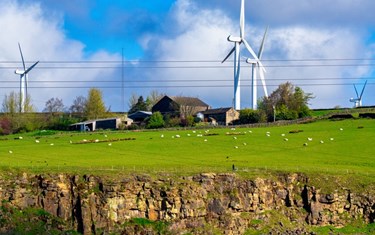RTPI response to DfT’s call for ideas on the Transport Decarbonisation Plan
August 2020
This response focuses on the contribution that spatial planning can make to transport decarbonisation by reducing travel demand, encouraging sustainable modal shift and facilitating the electrification of transport.
The RTPI is currently undertaking new research to further examine the contribution of spatial planning to transport decarbonisation. This seeks to build on the ideas presented below by setting out pathways to decarbonisation in different types of place, and clarifying the opportunities and challenges for delivery. This research is being conducted by LDA Design in partnership with City Science and Vectos, and will be published in November 2020. For more information, visit rtpi.org.uk/zerocarbontransport.
Read the RTPI's full response below or download the PDF
The role of spatial planning in enabling a place-based approach to transport decarbonisation
The Department for Transport’s document Decarbonising Transport: Setting the Challenge (March 2020) recognises that measures to reduce overall travel demand and increase the use of sustainable transport modes must accompany technological change, such as vehicle electrification, in order to meet the UK’s carbon emissions reduction commitments. The DfT has defined ‘place-based solutions’ as one of six strategic priorities for its Transport Decarbonisation Plan, which focuses on England.
Over the past thirty years, most of the increase in travel demand, the accompanying shift to car-dependency, and 70% of the increase in personal surface transport emissions has resulted from a dispersion of housing choices within the whole stock. This dispersion is driven by new development and the diversion of funding for regeneration, infrastructure and services in existing neighbourhoods[1]. The TDP should recognise that place-based approaches to decarbonisation therefore require the close integration of transport and spatial planning, at a range of spatial scales, identifying holistic solutions which are appropriate to the local context and deliver multiple benefits. There are a variety of mechanisms within the planning system that can support this, including:
- The ‘place-leadership’ role, where planners can coordinate across sectoral and geographical boundaries to create a shared vision and set of objectives for place, including sustainable transport and land use, and develop multi-agency delivery strategies[2]
- The local plan-making process, which can support a wider spatial vision for place by directing development towards locations which reduce travel demand and maximise accessibility by sustainable modes of transport, and identify the infrastructure needed to make development sustainable
- The development management process, which can influence design to support the vision and objectives for place, and restrict development which does not comply with national or local planning policy
- The use of planning obligations and conditions, which secure financial contributions for measures to reduce carbon emissions, such as public and active transport infrastructure, electric vehicle charging points and green infrastructure
A robust and resilient strategy for transport decarbonisation is also dependent on appropriate powers and resources being devolved to strategic and local planning authorities, who can in turn implement the TDP through their spatial visions, plans and policies. The recommendations below set out key areas for action.
Recommendations
Effective working between the DfT and the Ministry for Housing Communities and Local Government (MHCLG), along with other departments, to ensure that housing delivery is coordinated with interventions that enable significant modal shift to healthy, spatially efficient and low-carbon modes of transport.
Research from the RTPI, Transport for New Homes and the Place Alliance have found that too many major housing developments and urban extensions are not located or designed in ways that facilitate public and active travel, and therefore perpetuate and exacerbate car dependency[3].
There are a number of systemic factors which can lead to housing development in locations and forms which are inconsistent with transport decarbonisation. These are complex and include a lack of resourcing for local authority planning departments[4], fragmented governance structures for planning and transport[5], a transport appraisal and funding regime which favours road projects[6]. There is also insufficient data and a lack of understanding of the actual carbon impact of spatial and transport planning interventions.
National calculations of housing need are resulting in significant pressures for housing growth within and around urban areas, and where transport systems which are stretched or at capacity, current national planning policy is relatively weak on sustainable transport, and does not provide sufficient hooks or incentives to positively shape patterns of development and urban form to maximise accessibility by public and active modes of travel[7].
Better cross-departmental working is needed to better understand the carbon impact of decision making, and to ensure that growth is coupled with measures to reduce travel demand, maximise the efficiency of existing transport infrastructure, increase provision and capacity of public and active transport infrastructure, and promote relatively dense and compact patterns of development. This is especially important in the context of the government’s recent proposals for planning reform, which must deliver a more integrated approach to transport and land use planning.
The allocation of national transport infrastructure investment to projects which encourage sustainable transport and reduce car dependency
Rapid decarbonisation will be difficult to achieve when national transport investment is strongly geared towards the strategic and major road network, with far less spent on bus subsidy, walking, cycling and measures to reduce travel demand. This imbalance can induce and lock-in high carbon travel patterns by increasing road accessibility to peripheral land which a) encourages the relocation of residents and businesses to cheaper, car dependent locations and b) incentivises low-density development on lower-value land. This can increase overall traffic volumes, congestion, air pollution and carbon emissions, including in urban centres, which makes active travel less attractive[8].
The current transport appraisal system needs to be reformed to enable plans and developments to be tested against clear and agreed economic, social and environmental objectives. These should include measurably reducing the carbon emissions associated with transport and the need to travel, providing healthy, safe and secure ways of travelling for all ages and abilities, improving the built and natural environment to support local living and ’15 minute city’ principles, and creating genuinely sustainable patterns of development that are demonstrably consistent with national net-zero targets. Given the uncertainty created by Covid-19 and the transition to net zero carbon, appraisal should move away from the discredited ‘predict and provide’ model and instead actively help to realise a shared vision for place, reflecting the approaches of the ‘Vision and Validate’ and ‘Decide and Provide’ models[9]. This approach forms the basis of the RTPI’s current research to further examine the contribution of spatial planning to transport decarbonisation.
Wider measures, such as road user charging, can ensure that new and expanded road infrastructure does not increase transport emissions by improving access to more peripheral and remote locations. In the interim, increased fuel duty, or the greater adoption of schemes like Nottingham’s Workplace Parking Levy, could also reduce private vehicle use and create a source of tax revenue for public and active transport infrastructure.
The further devolution of powers and resources to combined authorities, sub-national transport bodies and other strategic partnerships to develop integrated strategies which can effectively decarbonise transport by:
- Planning new development in locations which minimise the need to travel, regulate parking provision and secure links to public and active transport networks
- Integrating demand management on the transport network, for example through emissions or congestion charging zones or other forms of pricing which internalise the costs of transport
- Integrating land-use and transport planning with decision-making for other infrastructure programmes with spatial implications, such as healthcare, education, and urban regeneration
- Coordinating between the public and private sector, including transport and land use planners, to encourage modal coordination and fare integration (as exists in London)
- Engaging effectively with local communities throughout the process
Measures to more effectively integrate bus services with rail and metro need to be given greater priority. It should be recognised that the planning system has a number of mechanisms which can enable improvements to bus facilities (bus lanes, stops etc.) as well as local service benefits. Ensuring that all relevant guidance and regulation recognise the links between transport and land use planning will ensure such benefits are achieved. Bus priority measures are particularly important in seeking to steer modal change towards more sustainable forms of transport. The planning profession have been called upon to be bolder in embracing digital technology and public transport providers should do the same, keeping abreast of new technologies such as more efficient electric and hydrogen buses, real time service information and on-demand booking, and ensuring that any supporting infrastructure such as charging points, information panels and user-friendly mobile apps are provided. Mobility hubs, bus stations, bus stops and taxi ranks need to be well located to support movement between key local destinations, and well designed and maintained, through consistently high and recognisable standards and good integration with pedestrian and cycle routes.
Delivering the TDP through local and strategic plans will require significant investment in skills, training and tools to enable greater collaboration between transport and land used planners, share best practice, and improve engagement with communities, infrastructure providers and other stakeholders. This should cover visioning, forecasting, modelling, policy-making and impact assessment. A common set of objectives for place would assist different professions to break out of their siloes and develop integrated solutions.
Reducing private motorised travel through policies which promote compact settlement patterns with higher levels of density, land use mix and accessibility
The RTPI has produced an evidence base to summarise the multiple co-benefits that can be achieved through planning compact settlements with higher levels of residential and transport density. There is strong evidence that these urban forms reduce the need to travel and facilitate public and active transport when compared to low-density and dispersed developments, and thereby reduce overall vehicle use[10]. There is a close relationship between residential density and accessibility, with larger local populations providing patronage for a wider range of local shops and services in convenient locations, within easy walking or cycling distance. Higher levels of residential density and land use mix around public transport stops also helps to make high-frequency services financially viable, and increases the number of public transport stops at the city-region scale. This in turn improves accessibility across the entire network, creating a virtuous cycle that reduces car dependency, increases levels of public and active transport and reduces the number of physically inactive ‘door to door’ trips. For example, London has higher than average levels of walking and cycling, and is the only city in England where the majority of journeys are not made by car. This is enabled in part by high public transport density, which means that a single stop can be used to access to a wide range of destinations.
In addition to lower transport emissions, these types of place deliver wider benefits which include improved physical and mental health, improved economic productivity through agglomeration, reduced air pollution, and the ability to protect open land for biodiversity, carbon sequestration, flood mitigation, agriculture and recreation[11]. During the Covid-19 pandemic, the reallocation of space towards active travel has also increased resilience, helping to accommodate social distancing, ease pressure on public transport, and help shops and restaurants to safely reopen[12].
The range of co-benefits indicates that planning compact settlement patterns should be prioritised as a low-regrets abatement option, coupled with policies that improve street connectivity, increase land use mix, reduce block sizes and provide high quality green spaces. However by increasing population density, intensification can also increases the amount of vehicle trips in a given area, leading to congestion and exposing a greater amount of people to polluted air. In the vast majority of urban environments, the health benefits of walking and cycling are even thought to outweigh the potential health risks from increased exposure to air pollution, especially if they replace car journeys. However, it is important to recognise and mitigate the trade-offs between intensification and air pollution. Policies to promote compact settlements and modal shift require complementary measures to restrict car movement, limit parking spaces, and locate key facilities like schools and hospitals in places which can be accessed without a car. Planning green spaces as networks of multifunctional green infrastructure can help to filter pollutants in street canyons while also supporting climate adaptation, encouraging active travel and improving mental and physical wellbeing[13].
A reduction in private motorised travel should be a necessary precondition to the phasing out of conventional vehicles and the electrification of transport. The CCC have recommended that 60% of all new car sales will need to be electric vehicles (EVs) by 2030 in order to meet the legally binding carbon budgets of the 2008 Climate Change Act, while scenario modelling by the National Grid indicates this may need to rise to almost 100% by 2050. The National Grid also suggest that the uptake of EVs could add between 6GW and 30GW to peak electricity demand, which currently stands at 60GW. While the transition to EVs will help to reduce emissions from the transport sector and tackle localised air pollution, it will require both increased capacity and faster decarbonisation in the power sector in order to reduce net emissions.
Additional emissions and pollutants will also be generated from the production of EVs, including lithium ion batteries, the installation of charging infrastructure, and the recycling and scrapping of conventional vehicles. More widely, a simple replacement of conventional vehicles with EVs misses a valuable opportunity to change the way that people engage with different mobility options, and to promote more equitable and healthy modes of transport.
This requires policies, measures and investments to reduce overall private vehicle journeys, such as committed investment in active and public transport infrastructure, and the rollout of innovative shared and demand-responsive mobility solutions, particularly in more rural locations where car dependence is highest. Locking in the travel behaviour changes observed during lockdown requires a major shift in attitudes and modal shift, which means that early street reallocation measures need to be vastly expanded and enhanced to create comprehensive active travel networks.
Strengthened national planning policy to direct development to locations which can be effectively served by sustainable modes of transport, and promote urban forms that favour walking, cycling and public transport
Planning policy and guidance needs to be strengthened to provide greater emphasis on transport decarbonisation. This is likely to require planning to concentrate development in a small number of strategic locations, and prioritise brownfield sites within large existing settlements or immediately around them, before expanding smaller towns, villages and rural areas. In order to promote sustainable mobility and reduce congestion, any development outside of large existing settlements should be located alongside well-served bus corridors and in close proximity to rail stations and other transport interchanges. This will encourage patronage and the recovery of public transport operators post-Covid, while reducing the use of the strategic road network. Similarly, any new sustainable transport infrastructure, like rail and bus routes, should be located based on their potential to connect existing car-dependent settlements to major concentrations of jobs and services, and to support new public transport-oriented development patterns.
At the neighbourhood and development scale, urban form can encourage sustainable travel through the design of fine-mesh grid networks, and by limiting the use of cul-de-sacs and other street layouts with poor levels of connectivity. Parking spaces should be set at a maximum of one per household, and ideally lower. This can also be achieved through proactive planning so that ambitions for better safety, better mobility and better streets can form the basis of development and infrastructure proposals, rather than being retrofitted in at a later date.
High levels of active travel also requires that there are sufficient local facilities and services, such as food stores, pharmacies, GPs, schools and parks, which are accessible by foot from all residential areas. However, this is not just the responsibility of transport and land use planners and their respective government departments, but relates more broadly to the issue of local government funding, which is needed to ensure that facilities like parks, libraries and community centres are kept open, and the extent to which decisions over the location of schools and healthcare facilities are integrated with wider transport and land use concerns.
[1] Alan Wenban-Smith. 2016. Land-use drivers of transport emissions – revisited. ICE Transport Journal.
[2] CIHT, 2019. Better Planning, Better Transport, Better Places
[3] RTPI, 2018: The Location of Development. Available from: rtpi.org.uk/locationofdevelopment
Foundation for Integrated Transport. 2018. Transport for New Homes. Available from: transportfornewhomes.org.uk/wp-content/uploads/2018/07/transport-for-new-homes-summary-web.pdf
Foundation for Integrated Transport. 2020. Garden Villages and Garden Towns: Visions and Reality. Available from: transportfornewhomes.org.uk/the-project/garden-villages-and-garden-towns
Place Alliance. 2020. A Housing Design Audit for England. Available from: placealliance.org.uk/research/national-housing-audit/
[4] Total net expenditure on planning in England fell 42% between 2009-10 and 2017-18, with two-thirds of total reductions falling on planning policy. See: RTPI, 2019: Resourcing Public Planning
[5] CIHT. 2019. Better Planning, Better Transport, Better Places. Available from: ciht.org.uk/knowledge-resource-centre/resources/better-planning-better-transport-better-places/
[6] CIHT. 2016. Uncertainty Ahead: Which Way Forward for Transport. Available from: ciht.org.uk/media/4809/ciht_futures_-_final_report_doc_a4_final_linked.pdf
[7] RTPI. 2018. Briefing note on the 2018 NPPF. Available from: rtpi.org.uk/media/2945680/RevisedNPPFbriefingnote.pdf
[8] RTPI. 2018. Settlement Patterns, Urban Form and Sustainable Development. Available from: rtpi.org.uk/media/2822766/settlementpatternsurbanformsustainability.pdf
[9] CIHT. 2019. Better Planning, Better Transport, Better Places. Available from: ciht.org.uk/knowledge-resource-centre/resources/better-planning-better-transport-better-places/
[10] RTPI. 2018. Settlement Patterns, Urban Form and Sustainable Development. Available from: rtpi.org.uk/media/2822766/settlementpatternsurbanformsustainability.pdf
[11] RTPI. 2018. Settlement Patterns, Urban Form and Sustainable Development. Available from: rtpi.org.uk/media/2822766/settlementpatternsurbanformsustainability.pdf
[12] RTPI, 2020. Plan The World We Need. Available from: rtpi.org.uk/research/2020/june/plan-the-world-we-need/
[13] Ibid


